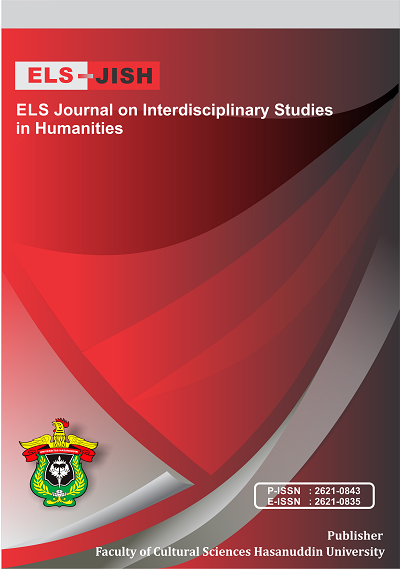Cultural Dimension of Black Representation of Ammatoa Community: Study of Cultural Semiotics
DOI:
https://doi.org/10.34050/elsjish.v3i4.12346Keywords:
Black Clothes, Ammatoa, Tallasak Kamase-MaseAbstract
One of the community groups in South Sulawesi Province, to be precise in Benteng Hamlet, Tana Toa Village, Kajang District, Bulukumba Regency is known as the Ammatoa community. This community is unique compared to other community groups in Bulukumba Regency, which always appears in black traditional clothes. Of course, this phenomenon raises academic questions as to why the Ammatoa community always appears in traditional black clothes. In fact, apart from always appearing in black, the Ammatoa community also has a white identity color, especially in “pacaka pute” (knee-length pants). However, this paper only focuses on black representations. This paper aims to examine the hidden dimension behind the black representation of the Ammatoa community in Bulukumba Regency, South Sulawesi. To analyze the cultural dimension in question, the semiotic theory of culture is used. Data were collected by means of participatory observation and interviews. The participatory observation method is carried out by directly observing the attitudes and patterns of daily life actions of the Ammatoa community. The interview method was carried out by interviewing the customary leader and several other community members about the cultural system or cultural value that underlies the appearance of the all-black clothing. Both methods are accompanied by audiovisual recording and note-taking techniques. Data were analyzed qualitatively - interpretatively. The results showed that the representation of black in the traditional clothing of the Ammatoa community has a symbolic meaning: (1) human life eventually becomes 'dark'; (2) the attitude of “sabbarak” (patient) , “gattang” (firm), “lambusuk” (honest), and “pisona” (surrender); (3) “tallasak kamase-mase ri lino” ('living unpretentiously in the world) and “kalumannyang kalupepeang allo ri boko” (rich in the afterlife), “inne lino pammari-mariangji” (this world is just a stopover), “akherak pammantang karakkang” (afterlife is an eternal place) . This concept is embedded in the oral folklore “pasang ri Kajang” 'messages (rules / norms) for the Kajang community'. In addition, there are pairs of signs of opposition (binnery opposotion), namely “pute”' (white) x “lekleng” (black / dark); “ammumba” (rising) x “sakra” (setting); “kamase-mase” (unpretentious) x “kalumannyang” (rich); “singarak” (light) x “sassang” (dark); “lino” ('world) 'x “akherak” (afterlife); “tallasak” (alive) x “mate” (dead).
References
Chandler, D. (2017). Semiotic The Basic - Third Edition. In Routledge, Taylor & Francis Group.
Hidayat, R. (2004). “Semiotika dan Bidang Ilmu”. Dalam T. Christomy dan Untung Yuwono (Ed.) Semiotika Budaya. Depok: Pusat Penelitian Kemasyarakatan dan Budaya, Direktorat Riset dan Pengabdian Masyarakat UI.
Hoed, H. (2008). Semiotik dan Dinamika Budaya. Jakarta: Fakultas Ilmu Pengetahuan Budaya, UI.
Johansen, J. D., & Larsen, S. E. (2002). Sign In Use: An Introduction to Semiotics. London: Routledge Taylor and Fracis Group.
Koentjaraningrat. (2002). Kebudayaan Mentalitas dan Pembangunan. Jakarta: Gramedia Pustaka Utama.
Kotta, Pillip Conrad. 2013. Anthropology: Appreciating Human Diversity. Fifteenth Edition. New York: McGraw-Hill.
Kurniawan. 2001.Semiologi Roland Barthes. Magelang: Indonesiatera.
Lorusso, A. M. (2015). Cultural Semiotics. In Cultural Semiotics. https://doi.org/10.1057/9781137546999
Maras, S. (2002). A Semiotics of the Proxy. Jurnal Social Semiotics, 12(1). Cartax Publishing, Taylor & Francis Group.
Masinambow, E.K.M dan Hidayat. (2002). Semiotik (Kumpulan Makalah Seminar). Depok: Pusat Penelitian Kemasyarakatan dan Budaya, Lemabaga Penelitian Uniersitas hasanuddin.
Noth, W. (1990). Handkbook of Semiotics. Bloomington: Indiana University Press.
Rahman, F. (2017). Analyzing Literary Works through Linguistic Structuralism Approach (Semiotics, Stylistics, Pragmatics). FIB Press - Faculty of Cultural Sciences Hasanuddin Univiersity.
Rahman, F. (2018). The Constraints of Foreign Learners in Reading English Literary Works: A Case Study at Hasanuddin University. Journal of Arts and Humanities, 7(2), 01. https://doi.org/10.18533/journal.v7i2.1327
Rahman, F., & Letlora, P. S. (2018). Cultural Preservation: Rediscovering the Endangered Oral Tradition of Maluku (A Case Study on Kapata of Central Maluku). Advances in Language and Literary Studies, 9(2), 91.
Rahman, F., Akhmar, A. M., & Amir, M. (2019, May). The Practice of Local Wisdom of Kajang People to Save Forests and Biodiversity: A Cultural-Based Analysis. In IOP Conference Series: Earth and Environmental Science (Vol. 270, No. 1, p. 012038). IOP Publishing.
Santosa, R. (2003). Semiotika Sosial; Pandangan terhadap Bahasa. Surabaya: Pustaka Eureke & JPP Press.
Sahib, H., Rahman, F., Duli, A., & Asba, A. R. (2019). Customary Forest Conservation through Informal Knowledge System of Ammatowa Community. In IOP Conference Series: Earth and Environmental Science (Vol. 270, No. 1, p. 012042). IOP Publishing.
Wiranata, I Gede. (2002). Antropologi Budaya. Bandung: Citra Aditya Bakti.
Downloads
Published
Issue
Section
License

This work is licensed under a Creative Commons Attribution-NonCommercial 4.0 International License.






